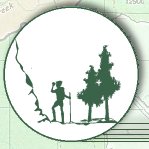
 |
 |
 |
 |
 |
 |
 |
 |
 |
The Road Less Traveled As Lee Bergthold's latest series of photographs in An Unforgiving Land clearly show, fascination with the Donner-Reed Party tragedy is still alive and well. The story of the unfortunate emigrants has become a monument—both figuratively and literally—in the history and the mythology of the American West. To a large degree, the story's popularity owes to a morbid attraction to an act considered to be one of the most reprehensible by most human societies—the eating of human flesh. In the years after news of the ordeal in the Sierra spread, arguments about the morality of cannibalism, even in such desperate situations, were bandied about in papers across the country.1 Today, the desperate measures taken by the starving immigrants are often reduced to jokes or tongue in cheek references. What Bergthold and this expedition have set out to do is to engender a renewed appreciation for the plight of the emigrants and to gain some perspective as we fly through the Nevada and Utah deserts at 70 miles per hour on the I-80. Somebody else had to cross that expanse first: to build the freeway, to connect east and west by rail and open the country up to settlements in the first place. The decision to attempt Lansford Hastings cutoff was the most grievous amongst many mistakes made by the Donner-Reed Party in their overland journey. Rather than taking the established route which swung to the northwest from Ft. Laramie in present day Wyoming to Ft. Hall in modern Idaho, the Donner-Reed Party, probably at the insistence of James F. Reed, proceeded to Ft. Bridger to the south and from there followed Hastings suggested route circling the Great Salt Lake to the south. An old military friend of Reed's even warned him about the perils of taking the cutoff route; James Clyman advised Reed to "take the regular wagon track, and never leave it—it is barely possible to get through if you follow it, and it may be impossible if you don't."2 However, a letter arriving from Hasings at Ft. Laramie promising to personally escort any wagon parties wanting to attempt the cutoff convinced Reed and the other party members that the shortcut was a viable option. In choosing the unorthodox route, they hoped to shave off about 300 miles and over a month from their journey. When they reunited with the California Trail west of Elko, NV, they were the only wagon party on the trail, having lost about a month and having practically blazed the trail themselves. Why would the Donner-Reed Party, with so much as stake, attempt an untried route that would take them through some of the most inhospitable land in the West? Hastings had just published a book describing California and the proposed cutoff that would lead emigrants to the territory that he was intent on developing. He had a reputation as a trailblazer, but had only attempted the route that he was proposing for the the wagons on horseback, and that only once, in an eastward direction. It was, as the crow flies, the most direct route to California, but Hastings took no account of the geography and the desolate land that had to be traversed. In this way, he embodied the same attitude adopted by later Americans—the the wild and vast lands of the American West could be bent to man's will and be colonized. A similar hubris may have played a part in the Donner-Reed Party's decision to take the cutoff. To attempt the California and Oregon Trails in the first place required a certain adventuring spirit, but the Donner-Reed Party had an opportunity to be some of the first pioneers to use a new route, trusting that Manifest Destiny would help them overcome andy challenges along the way. What fame and properties would await them in California when they arrived well before the other wagon trains by forging ahead on this new trail? Unfortunately, the obstacles were too great and the party would gain fame for quite another reason. The desire to impose man's will on the land is continued in Bergthold's expeditions. Bergthold, however, knows better than to think he can ignore the powers of nature and geography. His triumph comes from being able to access this remote region of the earth and traverse the land, not only surviving with few technological aids, but also being able to visually document his experience to share with his fellow countrymen. |
1. The California Star published the first account of cannibalism on February 13, 1847. |
|
 |
|